1999 HONDA CIVIC COUPE fuel
[x] Cancel search: fuelPage 226 of 269
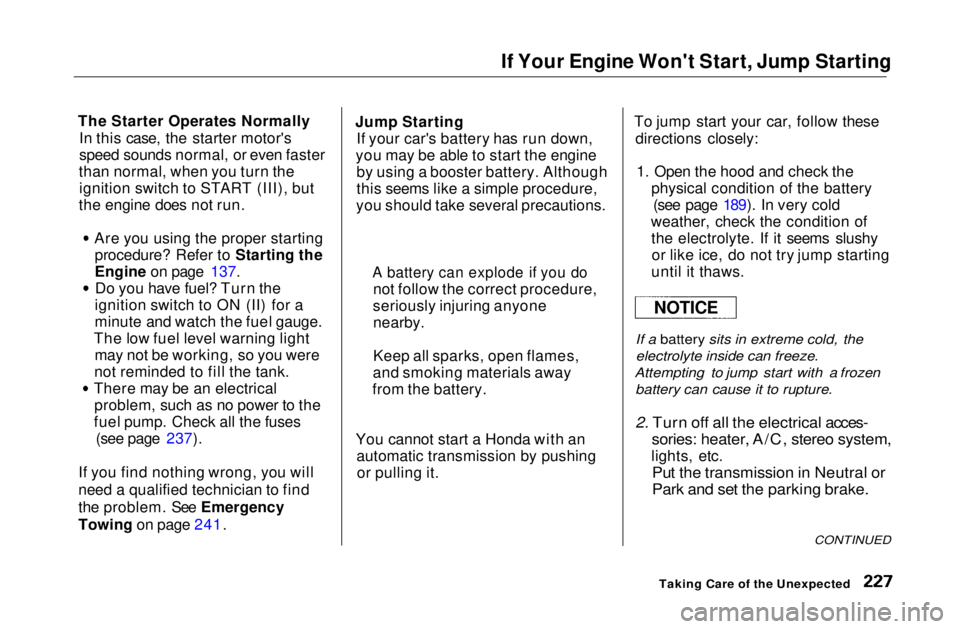
If Your Engine Won't Start, Jump Starting
The Starter Operates Normally In this case, the starter motor's
speed sounds normal, or even faster
than normal, when you turn the ignition switch to START (III), but
the engine does not run.
Are you using the proper startingprocedure? Refer to Starting the
Engine on page 137.Do you have fuel? Turn the
ignition switch to ON (II) for a
minute and watch the fuel gauge.
The low fuel level warning light may not be working, so you were
not reminded to fill the tank.
There may be an electrical problem, such as no power to the
fuel pump. Check all the fuses (see page 237).
If you find nothing wrong, you will
need a qualified technician to find
the problem. See Emergency
Towing on page 241. Jump Starting
If your car's battery has run down,
you may be able to start the engine by using a booster battery. Although
this seems like a simple procedure,
you should take several precautions.
You cannot start a Honda with an automatic transmission by pushingor pulling it. To jump start your car, follow these
directions closely:
1. Open the hood and check the physical condition of the battery(see page 189). In very cold
weather, check the condition of the electrolyte. If it seems slushyor like ice, do not try jump starting
until it thaws.
If a battery sits in extreme cold, the
electrolyte inside can freeze.
Attempting to jump start with a frozen
battery can cause it to rupture.
2. Turn off all the electrical acces-
sories: heater, A/C, stereo system,
lights, etc.
Put the transmission in Neutral or
Park and set the parking brake.
CONTINUED
Taking Care of the Unexpected
A battery can explode if you do
not follow the correct procedure,
seriously injuring anyone nearby.
Keep all sparks, open flames,
and smoking materials away
from the battery.
NOTICEMain Menu Table of Contents s t
Page 232 of 269
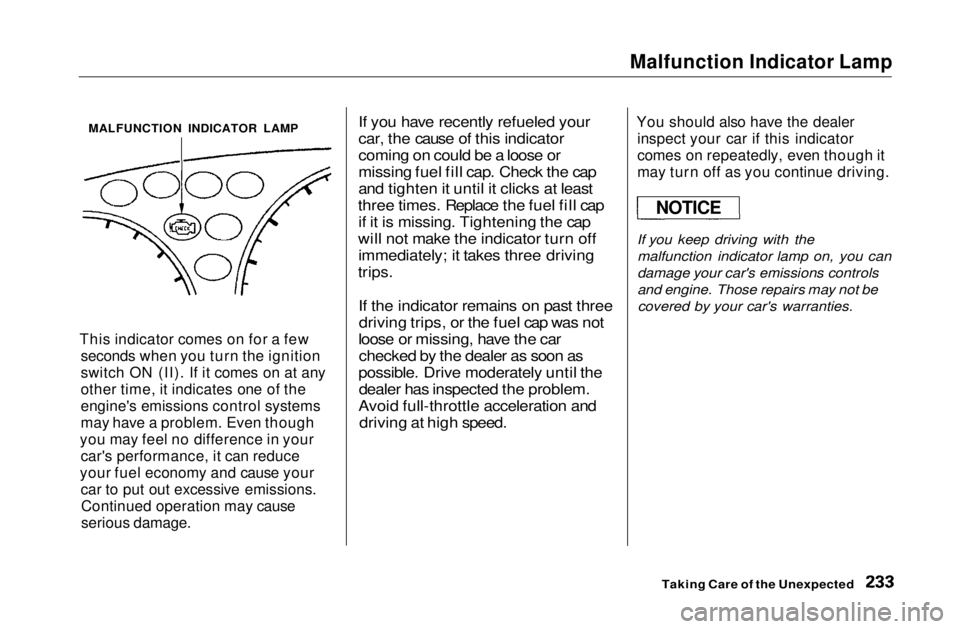
Malfunction Indicator Lamp
This indicator comes on for a few seconds when you turn the ignition
switch ON (II). If it comes on at any
other time, it indicates one of the
engine's emissions control systems
may have a problem. Even though
you may feel no difference in your car's performance, it can reduce
your fuel economy and cause your car to put out excessive emissions.Continued operation may cause
serious damage.
If you have recently refueled your
car, the cause of this indicator
coming on could be a loose or
missing fuel fill cap. Check the cap
and tighten it until it clicks at least
three times. Replace the fuel fill cap if it is missing. Tightening the cap
will not make the indicator turn off immediately; it takes three driving
trips.
If the indicator remains on past threedriving trips, or the fuel cap was not
loose or missing, have the car checked by the dealer as soon as
possible. Drive moderately until the dealer has inspected the problem.
Avoid full-throttle acceleration and driving at high speed.
You should also have the dealer
inspect your car if this indicator
comes on repeatedly, even though it
may turn off as you continue driving.
If you keep driving with the malfunction indicator lamp on, you can
damage your car's emissions controls
and engine. Those repairs may not becovered by your car's warranties.
Taking Care of the Unexpected
MALFUNCTION INDICATOR LAMP
NOTICEMain Menu Table of Contents s t
Page 242 of 269

Technical Information
The diagrams in this section give you the dimensions and capacities of
your Honda, and the locations of the identification numbers. The expla-
nations of several electronic and
mechanical systems on your Honda
are for the more technically-oriented
owner. Identification Numbers................. 244
Specifications................................. 246
Tire Information............................ 249 Tire Size Designation................ 249
Wheel Size Designation............ 249
Tire Speed Ratings.................... 249
Tire Pressure Adjustment For High Speed Driving............... 250
DOT Tire Quality Grading....... 250
Treadwear.............................. 250
Traction.................................. 251Temperature.......................... 251
Oxygenated Fuels.......................... 252
Driving in Foreign Countries....... 253 Emissions Controls........................ 254
The Clean Air Act...................... 254Crankcase Emissions Control System..................................... 254
Evaporative Emissions Control System..................................... 254
Onboard Refueling Vapor Recovery................................. 254
Exhaust Emissions Controls.... 255 PGM-FI System..................... 255
Ignition Timing ControlSystem................................. 255
Exhaust Gas Recirculation (EGR) System.................... 255
Three Way Catalytic Converter............................ 255
Replacement Parts..................... 255
Three Way Catalytic Converter... 256
Technical InformationMain Menu s t
Page 251 of 269
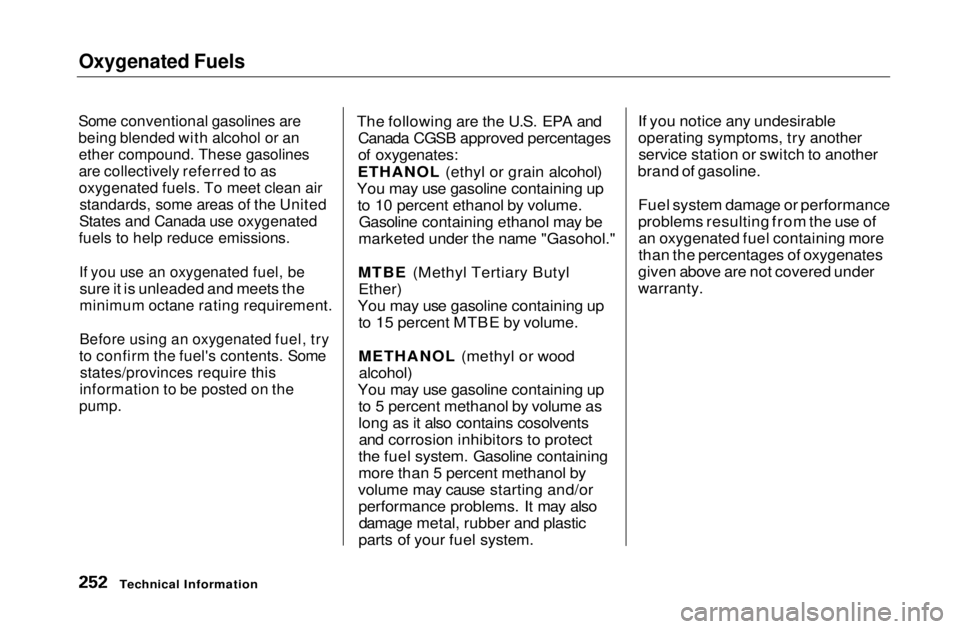
Oxygenated Fuels
Some conventional gasolines are
being blended with alcohol or an
ether compound. These gasolines
are collectively referred to as
oxygenated fuels. To meet clean air
standards, some areas of the United
States and Canada use oxygenated
fuels to help reduce emissions.
If you use an oxygenated fuel, be
sure it is unleaded and meets the
minimum octane rating requirement.
Before using an oxygenated fuel, try
to confirm the fuel's contents. Some
states/provinces require this
information to be posted on the
pump.
The following are the U.S. EPA and
Canada CGSB approved percentages
of oxygenates:
ETHANOL (ethyl or grain alcohol)
You may use gasoline containing up to 10 percent ethanol by volume. Gasoline containing ethanol may be
marketed under the name "Gasohol."
MTBE (Methyl Tertiary Butyl Ether)
You may use gasoline containing up to 15 percent MTBE by volume.
METHANOL (methyl or wood
alcohol)
You may use gasoline containing up to 5 percent methanol by volume as
long as it also contains cosolventsand corrosion inhibitors to protect
the fuel system. Gasoline containing
more than 5 percent methanol by
volume may cause starting and/or performance problems. It may alsodamage metal, rubber and plastic
parts of your fuel system. If you notice any undesirable
operating symptoms, try another
service station or switch to another
brand of gasoline.
Fuel system damage or performance
problems resulting from the use of
an oxygenated fuel containing more
than the percentages of oxygenates
given above are not covered under
warranty.
Technical InformationMain Menu Table of Contents s t
Page 252 of 269

Driving in Foreign Countries
Technical Information
If you are planning to take your
Honda outside the U.S. or Canada,
contact the tourist bureaus in the
areas you will be traveling in to find
out about the availability of unleaded
gasoline with the proper octane
rating.
If unleaded gasoline is not available,
be aware that using leaded gasoline in your Honda will affect perfor-
mance and fuel mileage, and damage
its emissions controls. It will no
longer comply with U.S. andCanadian emissions regulations, and
will be illegal to operate in North
America. To bring your car back into compliance will require the replace-
ment of several components, such as
the oxygen sensors and the three
way catalytic converter. These re- placements are not covered under
warranty.Main Menu Table of Contents s t
Page 253 of 269
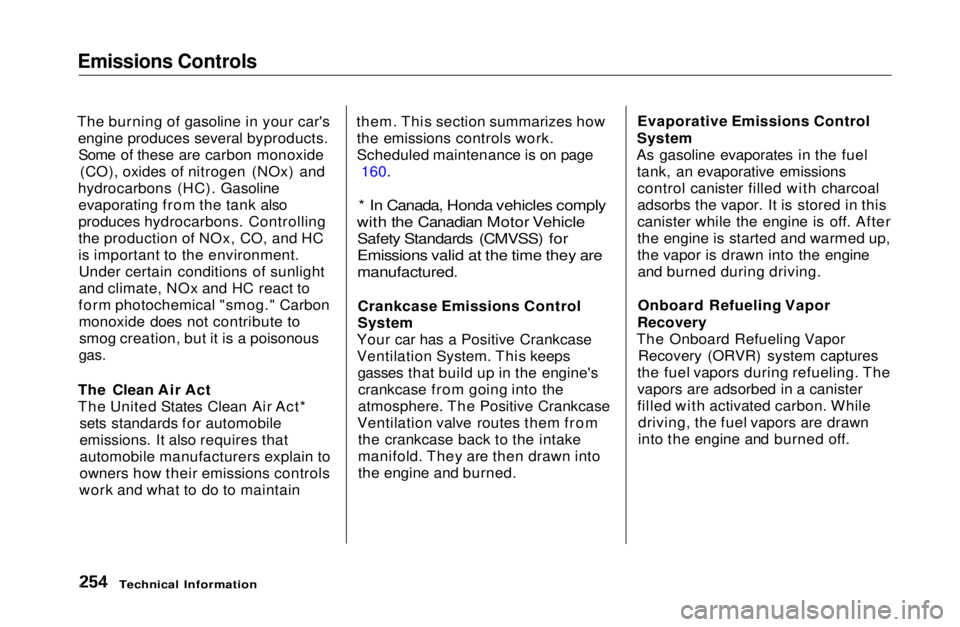
Emissions Controls
The burning of gasoline in your car's engine produces several byproducts.Some of these are carbon monoxide (CO), oxides of nitrogen (NOx) and
hydrocarbons (HC). Gasoline evaporating from the tank also
produces hydrocarbons. Controlling
the production of NOx, CO, and HC
is important to the environment.Under certain conditions of sunlight
and climate, NOx and HC react to
form photochemical "smog." Carbon monoxide does not contribute tosmog creation, but it is a poisonous
gas.
The Clean Air Act
The United States Clean Air Act* sets standards for automobile
emissions. It also requires that
automobile manufacturers explain to
owners how their emissions controls
work and what to do to maintain them. This section summarizes how
the emissions controls work.
Scheduled maintenance is on page 160.
* In Canada, Honda vehicles comply
with the Canadian Motor Vehicle Safety Standards (CMVSS) for
Emissions valid at the time they are
manufactured.
Crankcase Emissions Control
System
Your car has a Positive Crankcase
Ventilation System. This keeps gasses that build up in the engine'scrankcase from going into the
atmosphere. The Positive Crankcase
Ventilation valve routes them from the crankcase back to the intake
manifold. They are then drawn into
the engine and burned. Evaporative Emissions Control
System
As gasoline evaporates in the fuel tank, an evaporative emissionscontrol canister filled with charcoal
adsorbs the vapor. It is stored in this
canister while the engine is off. After
the engine is started and warmed up,
the vapor is drawn into the engineand burned during driving.
Onboard Refueling Vapor
Recovery
The Onboard Refueling Vapor Recovery (ORVR) system captures
the fuel vapors during refueling. The
vapors are adsorbed in a canister
filled with activated carbon. While driving, the fuel vapors are drawn
into the engine and burned off.
Technical InformationMain Menu Table of Contents s t
Page 254 of 269

Emissions Controls
Exhaust Emissions Controls
The exhaust emissions controls include three systems: PGM-FI,
Ignition Timing Control and Three
Way Catalytic Converter. These three systems work together tocontrol the engine's combustion and
minimize the amount of HC, CO, and
NOx that comes out the tailpipe. Theexhaust emissions control systems
are separate from the crankcase and
evaporative emissions control
systems.
PGM-FI System
The PGM-FI System uses sequential multiport fuel injection.
It has three subsystems: Air Intake,Engine Control, and Fuel Control.
The Engine Control Module (ECM)/ Powertrain Control Module (PCM)/
Transmission Control Module (TCM-HX model only) uses various
sensors to determine how much air
is going into the engine. It then controls how much fuel to inject under all operating conditions.
Ignition Timing Control System
This system constantly adjusts the ignition timing, reducing the amountof HC, CO and NOx produced.
Exhaust Gas Recirculation (EGR) System
Only on HX model
The Exhaust Gas Recirculation (EGR) system takes some of the
exhaust gas and routes it back into
the intake manifold. Adding exhaust
gas to the air/fuel mixture reduces
the amount of NOx produced when
the fuel is burned.
Three Way Catalytic Converter
The three way catalytic converter is in the exhaust system. Throughchemical reactions, it converts HC,
CO, and NOx in the engine's exhaust
to carbon dioxide (CO 2), dinitrogen
(N2), and water vapor. Replacement Parts
The emissions control systems are designed and certified to work to-
gether in reducing emissions to
levels that comply with the Clean Air
Act. To make sure the emissions remain low, you should use only new Genuine Acura replacement parts or
their equivalent for repairs. Using lower quality parts may increase the
emissions from your car.
The emissions control systems are covered by warranties separate from
the rest of your car. Read your
warranty manual for more informa- tion.
Technical InformationMain Menu Table of Contents s t
Page 262 of 269
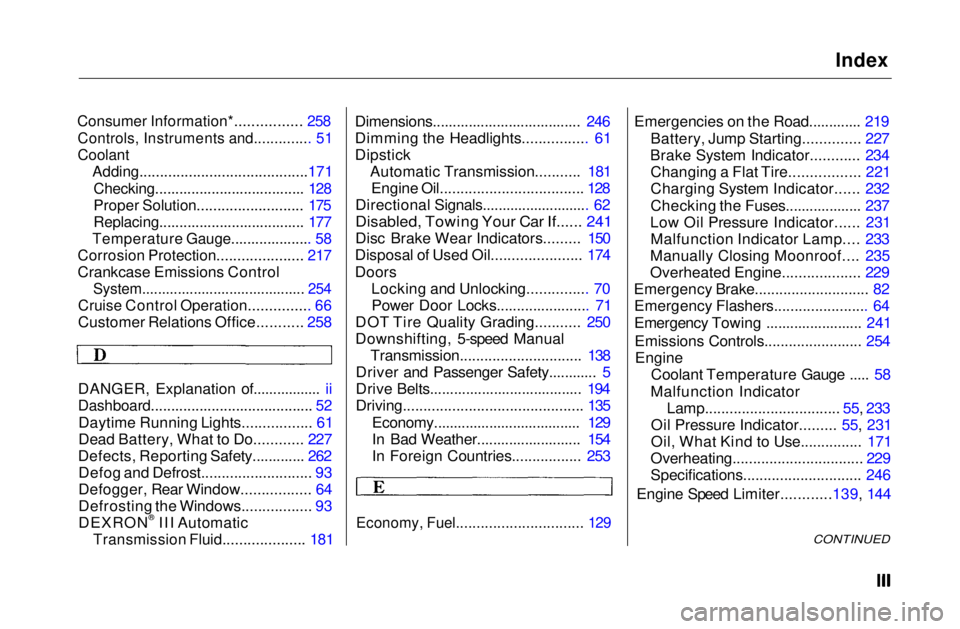
Index
Consumer Information*................ 258
Controls, Instruments and.............. 51
Coolant
Adding.........................................171
Checking..................................... 128
Proper Solution.......................... 175
Replacing.................................... 177
Temperature Gauge.................... 58
Corrosion Protection..................... 217
Crankcase Emissions Control
System......................................... 254
Cruise Control Operation............... 66
Customer Relations Office........... 258
DANGER, Explanation of................. ii
Dashboard........................................ 52
Daytime Running Lights................. 61
Dead Battery, What to Do............ 227
Defects, Reporting Safety............. 262 Defog and Defrost........................... 93
Defogger, Rear Window................. 64
Defrosting the Windows................. 93
DEXRON® III Automatic
Transmission Fluid.................... 181
Dimensions..................................... 246
Dimming the Headlights................ 61
Dipstick
Automatic Transmission........... 181
Engine Oil................................... 128
Directional Signals........................... 62
Disabled, Towing Your Car If...... 241
Disc Brake Wear Indicators......... 150
Disposal of Used Oil...................... 174
Doors Locking and Unlocking............... 70Power Door Locks....................... 71
DOT Tire Quality Grading........... 250
Downshifting, 5-speed Manual Transmission.............................. 138
Driver and Passenger Safety............ 5
Drive Belts...................................... 194
Driving............................................ 135
Economy..................................... 129
In Bad Weather.......................... 154
In Foreign Countries................. 253
Economy, Fuel............................... 129
Emergencies on the Road............. 219
Battery, Jump Starting.............. 227
Brake System Indicator............ 234 Changing a Flat Tire................. 221
Charging System Indicator...... 232
Checking the Fuses................... 237
Low Oil Pressure Indicator...... 231 Malfunction Indicator Lamp.... 233
Manually Closing Moonroof.... 235
Overheated Engine................... 229
Emergency Brake............................ 82 Emergency Flashers....................... 64
Emergency Towing ........................ 241
Emissions Controls........................ 254Engine Coolant Temperature Gauge ..... 58
Malfunction Indicator Lamp................................. 55, 233
Oil Pressure Indicator......... 55, 231
Oil, What Kind to Use............... 171
Overheating................................ 229
Specifications............................. 246
Engine Speed Limiter............139, 144
CONTINUEDMain Menu s t